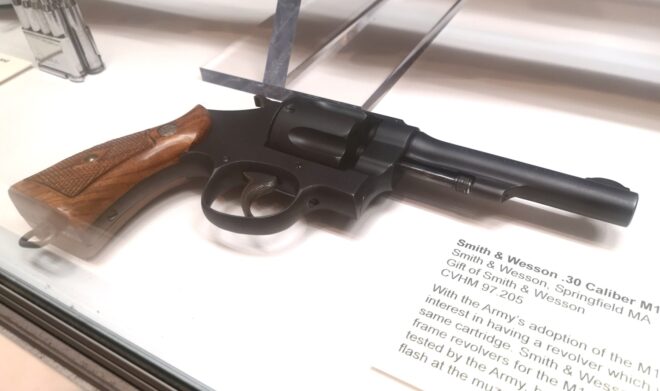I recently had the chance to visit Springfield, Massachusetts while giving a talk at the Arsenals of History Symposium at the Springfield Armory. While in Springfield, I checked out their local museum (technically 5 museums in one!), tucked away in the Lyman and Merrie Wood Museum of Springfield History was an interesting firearms gallery. The museum boasts “more than 1,600 firearms, with the largest collection of Smith & Wesson guns in the world”. While only a fraction of those firearms are on display, the museum definitely had some very interesting pieces.
Wheelgun Wednesday @ TFB:
- Putting XS Sights on the Taurus 605 Defender
- Revolvers vs Bears – Survive an Apex Predator
- Current Chinese Police Revolvers – NRP9 and ZLS05
- Taurus 856 TORO Review – 1st Optics-Ready Revolver
- Top Revolver Hunting Ammo For 2023
The Smith & Wesson gallery attempted to give an overview of American firearms development from the 1600s right through to the 21st century – no small task. It also tries to illustrate the role the Connecticut River Valley and Smith & Wesson specifically have played.
The displays include Revolutionary War era muskets, early breechloaders, Civil War era firearms and of course a fairly comprehensive display of early Smith & Wessons including Model 2s and Model 3s.

One of the Smith & Wesson Gallery of Firearms History display cases featuring some interesting 20th-century firearms (Matthew Moss)
Other interesting weapons on display include Smith & Wesson’s ill-fated 9x19mm pistol caliber carbine, the Model 1940 Light Rifle, their carbine prototype, with serial number X1, chambered in .30 Carbine built in 1944 and a couple of intriguing revolvers which I’d never come across before.
Above is Smith & Wesson’s attempt to produce an N-Frame revolver chambered in .30 Carbine. The museum’s display suggests that with the US Army’s adoption of the M1 Carbine, Smith & Wesson decided to develop a revolver that would allow troops to use the same cartridge. Likely using moon clips the revolver has a standard six-chamber cylinder. The display notes that the revolver was tested by the Army but not pursued due to “tremendous blast and flash at the muzzle”. It would be another 30 years before the Ruger Blackhawk came along for a revolver chambered in .30 Carbine to be offered commercially.
Another interesting revolver caught my eye because of its unusual stock. Smith & Wesson’s undated survival pistol, developed during the Cold War, was chambered in .22 caliber and was able to use both .22LR and .22 Hornet. Seemingly based on the K-frame, the revolver was intended for issue to US military aircrews to allow downed crews to hunt for small game and protect themselves. Like other survival guns, the stock served as the weapon’s holster and it also has a pair of Weaver scope mounts on the top strap and on the mid-point of the barrel. Sadly, it appears that the underside of the polymer stock has been damaged. Despite this, it’s a fascinating relic of the Cold War which never went into production.
This article highlights just a few of the guns on display, find out more about the museum here.
 Your Privacy Choices
Your Privacy Choices




